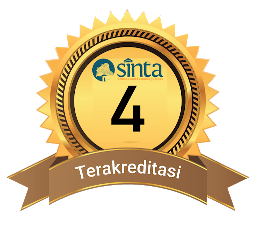Development of Augmented Reality-Based Chemistry Learning Media on Carbon Compound Material
DOI:
10.29303/cep.v8i1.6854Published:
2025-05-31Issue:
Vol. 8 No. 1 (2025): Edisi MeiArticles
Downloads
How to Cite
Abstract
This study aims to determine the feasibility and practicality of interactive learning media based on augmented reality for carbon compounds. This research is a type of development research that adopts the 4D model (define, design, develop, disseminate) but is limited only to the development stage (develop). The population in this study consisted of 124 students from SMAN 1 Labuhan Haji. The sampling technique used in this study was random sampling. The assessment aspects evaluated by three validators have three aspects measured through expert validation sheets. The level of practicality of the media was measured through a practicality questionnaire sheet completed by 24 students of Class XI MIPA at SMAN 1 Labuhan Haji. The results showed that the level of media feasibility, as assessed by the validator, was 0.68, indicating that the developed media had a high level of validity. The results of the media practicality test showed that students gave positive responses to all media components, with a practicality percentage of 87.5%. Based on these results, it can be concluded that the media developed is feasible and practical to use.
References
Ariaji, R., Nasirsah & Siregar, S., (2020). Pengembangan Video Pembelajaran Kimia SMA/MA Menggunakan Camtasia Studio 8. JurnalPenelitian dan Pembelajaran MIPA, 5(1),55-64. doi: http://dx.doi.org/10.31604/eksakta.v5i1.55-64
Ismawati, S., & Mustika, D. (2021). Validitas Media Video Berbasis Animasi Dalam Pembelajaran Tematik. Journal Of Social Science Research, 1(2), 291-297. Retrieved from Retrieved from http://j-innovative.org/index.php/Innovative/article/view/52
Jahro Lis, & Susilawati. (2009). Analisis Penerapan Metode Praktikum pada Pembelajaran Ilmu Kimia di Sekolah Menengah atas. Digital Repository Universitas Negeri Medan, 5(2), 20–26. uri: https://digilib.unimed.ac.id/id/eprint/278
Krisdiawan, R. A., Priantama, R., Praramdani, E., & Artikel, H. (2023). Media Edukasi Biota Laut Berbasis Augmented Reality Menggunakan Metode Marker Based Tracking dengan Algoritma Fast Corner Detection. Digital Transformation Technology (Digitech), 3(1), 38-48.
Lee, K., & Chung, G. K. W. K. (2021). The Effectiveness of Augmented Reality in Education: A Meta-Analysis. Educational Technology Research and Development, 55(3), 1–29.
Lestari I. (2013). Pengembangan Bahan Ajar Berbasis Kompetensi. Akademi Permata 1.
Lestari N., & Wirasty R., (2019). Pemanfaatan Multimedia Dalam Media Pembelajaran Interaktif Untuk Meningkatkan Minat Belajar Siswa. Jurnal Amaliah, 3(2), 349-353. DOI: https://doi.org/10.32696/ajpkm.v3i2.289
Nabillah, T., & Abadi, A. P. (2019). Prosiding Seminar Nasional Matematika dan Pendidikan Matematika Sesiomadika.
Priliyanti, A., Muderawan, I. W., & Maryam, S. (2021). Analisis Kesulitan Belajar Siswa Dalam Mempelajari Kimia Kelas XI. Jurnal Pendidikan Kimia Undiksha, 5(1), 11–18. URI: http://repo.undiksha.ac.id/id/eprint/1158
Rahayu, K., Wigati, I., & Astuti, R. (2022). Analisis Kesulitan belajar Siswa Dalam Memahami Ikatan Kimia. Prosiding Seminar Nasional Pendidikan Kimia 2022, 1(1), 184-194.
Supriadi, S., Ibnu, S., & Yahmin, Y. (2018). Analisis Model Mental Mahasiswa Pendidikan Kimia Dalam Memahami Berbagai Jenis Reaksi Kimia. Jurnal Pijar Mipa, 13(1), 1–5. 1–5. https://doi.org/10.29303/jpm.v13i1.433
Supriadi, S., Wildan, W., Hakim, A., Savalas, L. R. T., & Haris, M. (2021). Model Mental dan Kemampuan Spasial Mahasiswa Tahun Pertama dan Ketiga Pendidikan Kimia di Universitas Mataram. Jurnal Pijar Mipa, 16(3), 282–287. https://doi.org/10.29303/jpm.v16i3.1366
Suryaman, M., Setiyani, L., Gunawan, R., Santoso, D., Fitriyani, R., & Ikhsan, N. (2023). Pengenalan Pemanfaatan Teknologi Virtual Reality (VR) dan Augmented Reality (AR) dalam Proses Pembelajaran kepada Para Guru dan Siswa di SMK Negeri 1 Cilamaya Kabupaten Karawang. Jurnal Pengabdian Mandiri, 2(1), 282-287. Retrieved from https://bajangjournal.com/index.php/JPM/article/view/4678
Zakiyah, Ibnu, S., & Subandi, S. (2018). Analisis Dampak Kesulitan Siswa pada Materi Stoikiometri terhadap Hasil Belajar Termokimia dan Upaya Menguranginya dengan Metode Pemecahan Masalah. EduChemia (Jurnal. DOI: http://dx.doi.org/10.30870/educhemia.v3i1.1784
Dendodi, D., Simarona, N., Elpin, A., Bahari, Y., & Warneri, W. (2024). Analisis Penerapan Augmented Reality dalam Meningkatkan Efektifitas Pembelajaran Sains di Era Digital. ALACRITY: Journal of Education, 293-304. https://doi.org/10.52121/alacrity.v4i3.456
Bau, C. P., Olii, S., & Pakaya, N. (2022). Perbandingan motivasi belajar pada mata pelajaran kimia sebelum dan sesudah penerapan media pembelajaran augmented reality chemistry. Inverted: Journal of Information Technology Education, 2(1), 44-53. https://doi.org/10.37905/inverted.v2i1.12978
Author Biographies
Samsul Sahidi, Pendidikan Kimia, Universitas Mataram
Supriadi Supriadi, Pendidikan Kimia, Universitas Mataram
License
Copyright (c) 2025 Samsul Sahidi, Jeckson Siahaan, Supriadi

This work is licensed under a Creative Commons Attribution-ShareAlike 4.0 International License.
Authors who publish with Chemistry Education Practice agree to the following terms:
- Authors retain copyright and grant the journal right of first publication with the work simultaneously licensed under a Creative Commons Attribution License 4.0 International License (CC-BY-SA License). This license allows authors to use all articles, data sets, graphics, and appendices in data mining applications, search engines, web sites, blogs, and other platforms by providing an appropriate reference. The journal allows the author(s) to hold the copyright without restrictions and will retain publishing rights without restrictions.
- Authors are able to enter into separate, additional contractual arrangements for the non-exclusive distribution of the journal's published version of the work (e.g., post it to an institutional repository or publish it in a book), with an acknowledgement of its initial publication in Chemistry Education Practice.
- Authors are permitted and encouraged to post their work online (e.g., in institutional repositories or on their website) prior to and during the submission process, as it can lead to productive exchanges, as well as earlier and greater citation of published work (See The Effect of Open Access).






